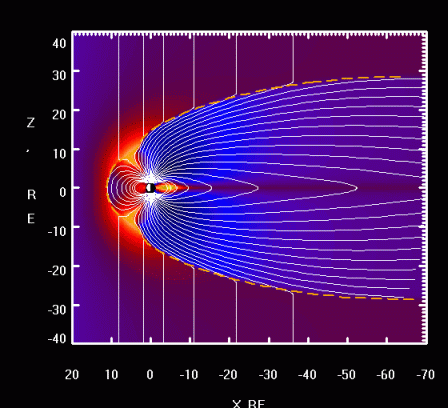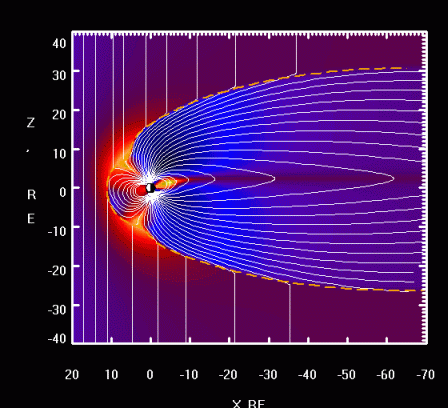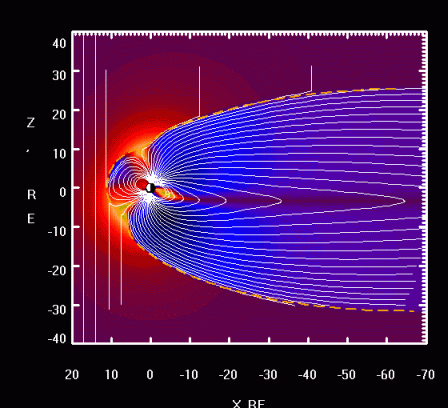The external magnetic field is not symmetric due to solar influence. We concentrate the attention on the Tsyganenko models that are semi-empirical best-fit representations for the magnetic field, based on a large number of satellite observations. The models include the contributions from major external magnetospheric sources: ring current, magnetotail current system, magnetopause currents, and large-scale system of field-aligned currents. The models adopted are described as follow:
- Model T89: was developed as a simple empirical approximation for the global magnetosphere depending on a disturbance index Kp (see Tsyganenko 1989a and Tsyganenko 1989b);
- Model T96: the spatial boundary of T96 is an hemi-ellipsoid on the dayside, which merges in the magnetotail with a cylindrical surface based on the average magnetopause of Sibeck et al. (1991). The field derives from the sum of five physically different magnetic field vectors, including contributions from the Chapman-Ferraro current (BCF), symmetric ring current (BSRC), cross-tail current sheet (BTC), large-scale field-aligned currents (BFAC) and partial penetration of the Interplanetary Magnetic Field (IMF) into the model magnetosphere (BINT). The magnetic field data include measurements from IMP, HEOS, and ISEE satellites. The parameters of the model are the solar wind ram pressure pdyn, Dst-index, transverse components (By and Bz) of the IMF and the dipole tilt angle. Each magnetic field source is a function of spatial position and model input parameters, where the function coefficients are determined by data fits (Tsyganenko 1995, Tsyganenko 1996);
- Model T02: the variabilities of the inner and near magnetosphere for different interplanetary conditions, the ground disturbance levels and the observed dawn-dusk asymmetry of the inner magnetosphere due to the partial ring current that develops during magnetospheric disturbances are keep into account (Tsyganenko 2002a, Tsyganenko 2002b);
- Model TS05: TS05 was specifically developed to reproduce the storm-time magnetosphere. The field is confined within a dynamical magnetopause, based on the empirical model of Shue et al. (1997) where, on the nightside, its region of validity is limited to tailward distances ≤15 RE. It is parametrized by dynamical solar wind inputs and includes a non-linear saturation of the field sources for strong solar wind conditions. The magnetic field data set for this model is based on 37 storm events that occurred between 1996 and 2000 and were observed by GOES, Polar, Geotail, and Equator-S satellites. TS05 model combines the T96 parameters with other six (W1,...,W6) defining the strengths of individual field sources; each parameter quantifies the combined effect of the interplanetary driving of the magnetospheric currents and their relaxation toward an unperturbed state (Tsyganenko and Sitnov 2005).

Figure 1: Animation on how the magnetospheric field varies in response to the diurnal wobbling of the geodipole.
http://geo.phys.spbu.ru//~tsyganenko/modeling.html

Figure 2: Animation on the interaction between the terrestrial and interplanetary fields.
http://geo.phys.spbu.ru//~tsyganenko/modeling.html

Figure 3: Animation illustrating the dynamical changes of the global magnetic field in the course of a disturbance.


